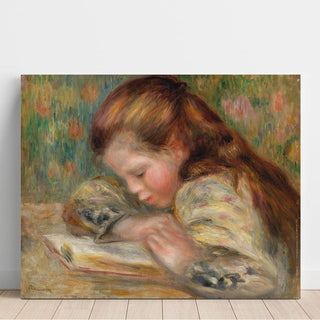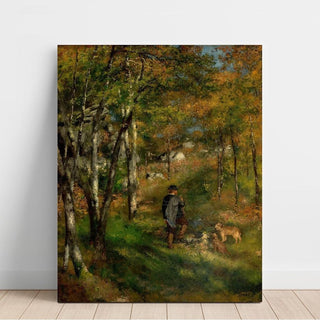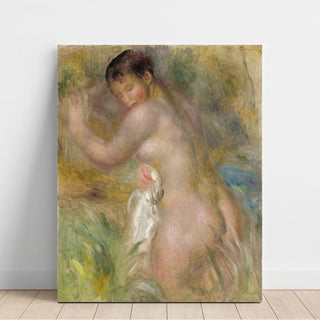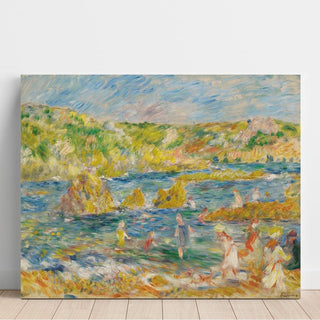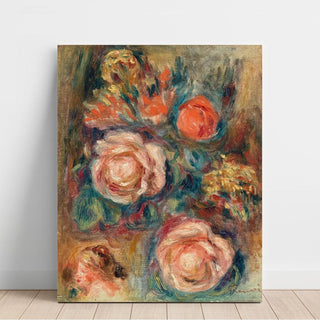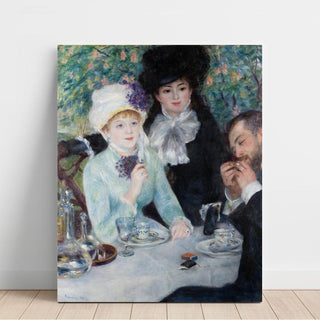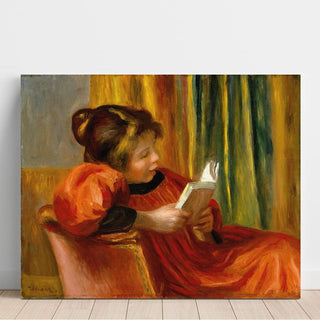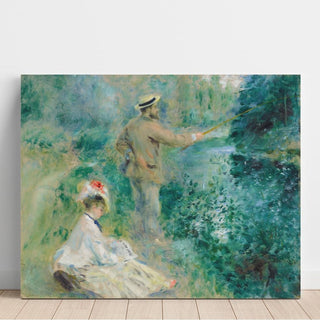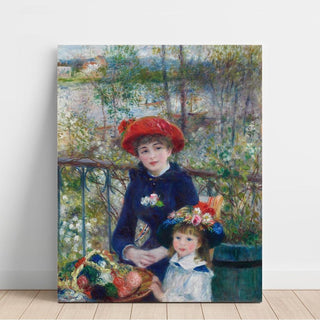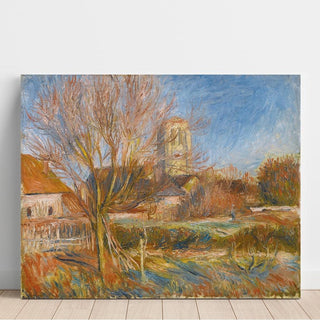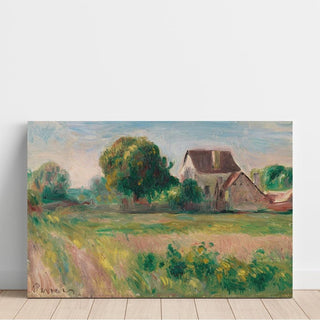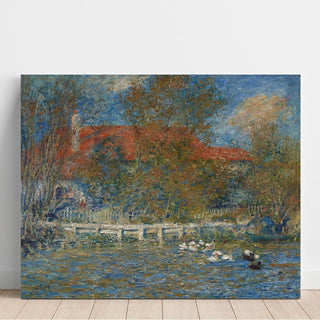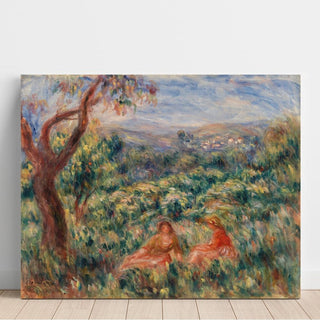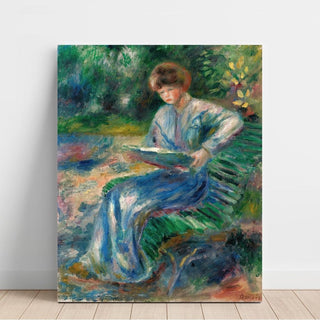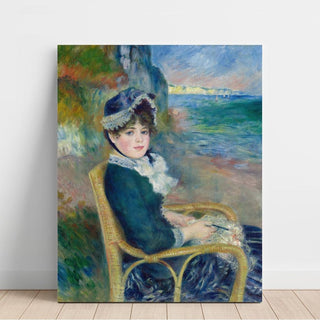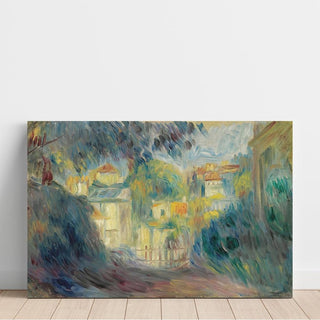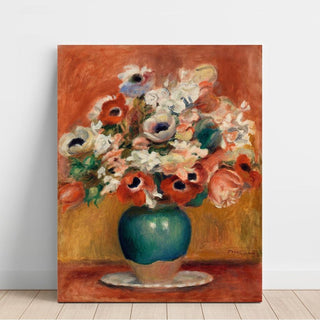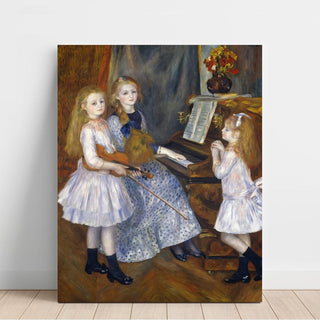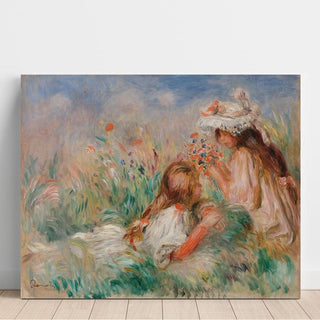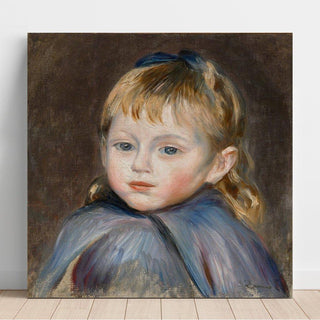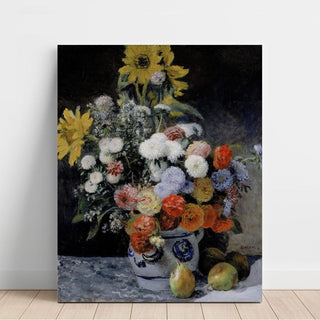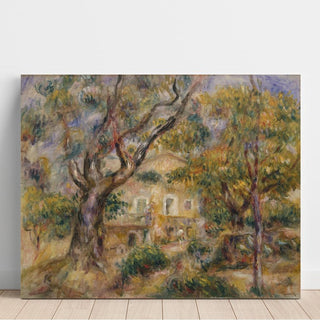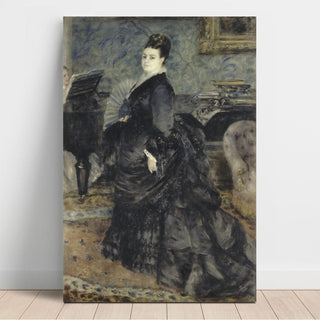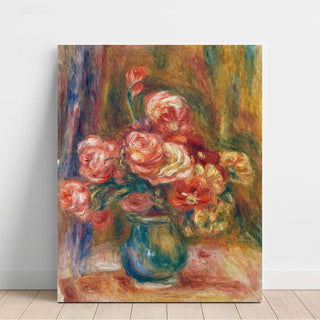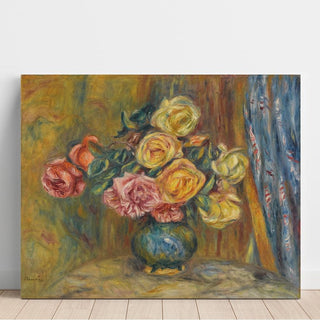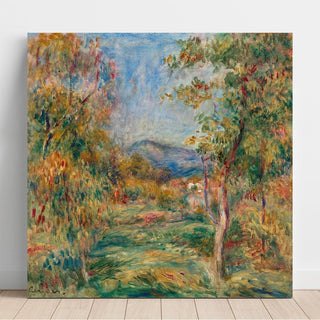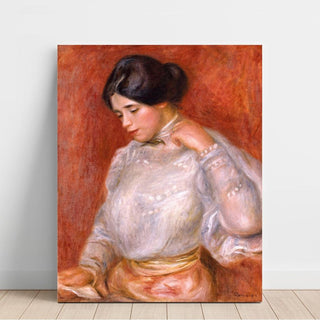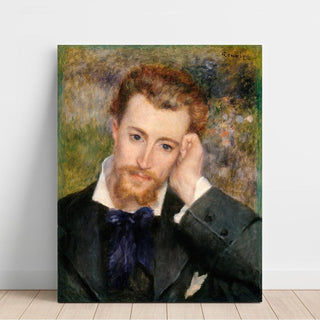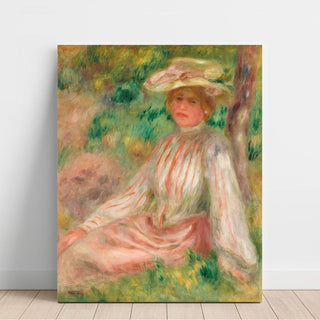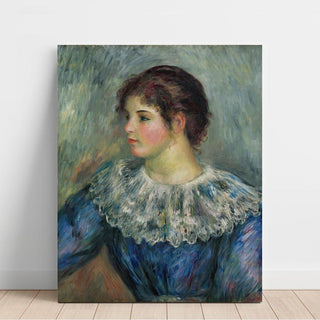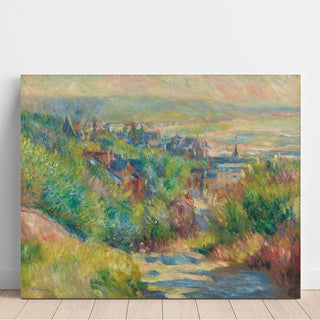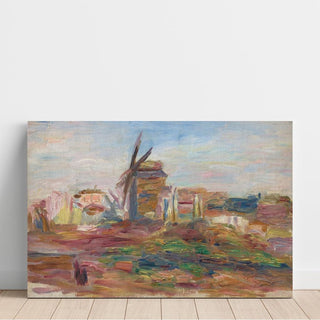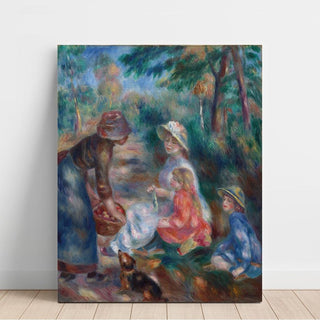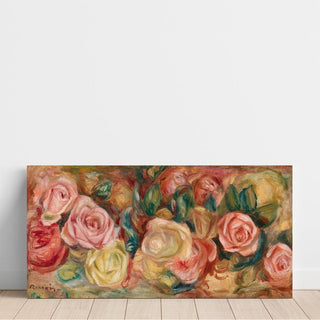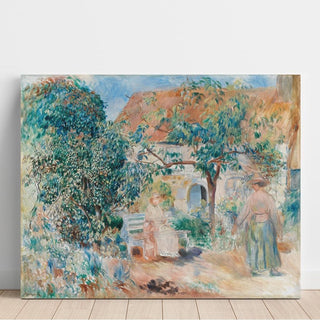Art print Renoir: Discover the Paintings of Pierre-Auguste Renoir
Introduction to Pierre-Auguste Renoir: The Journey of a Master of Impressionism
Pierre-Auguste Renoir, French impressionist painter born in Limoges in 1841, quickly became a major figure in modern art. Renoir's biography sheds light on his artistic journey and highlights the different stages of his life. This painter is distinguished by his unique ability to capture the French joie de vivre through revolutionary luminous scenes. Before adopting impressionism, Renoir belonged to the fine arts tradition, having taken courses at the Paris School of Fine Arts, which strongly influenced his technique. His meeting and collaboration with Claude Monet marked his beginnings in impressionism, a movement to which he made an essential contribution. Renoir's studio, notably in Essoyes, played a central role in his creative process and the evolution of his style. He adopted impressionism before moving towards other styles, marking an important transition in his career. Bright color and delicate touch characterize his works, bringing his everyday life scenes to life. Grace shines through in his portraits and life scenes, conferring elegance and sensuality to his paintings. His sons, who sometimes served as models, influenced some of his works and reveal the importance of family in his creation. The end of his life, marked by his death in 1919, coincides with a stylistic evolution towards more realistic works. Renoir's personal and artistic history is reflected in each of his works, each page of his career representing a key stage in his evolution. Each part of his work explores varied themes, from motherhood to everyday life scenes. The influence of Ingres is felt in his classical period, notably in the mastery of drawing and form. Paul Durand-Ruel, art dealer, played a decisive role in the international dissemination of his art. Action and movement are omnipresent in his paintings, capturing the energy and vitality of his characters.
"Auguste Renoir shows a particular attention to the evolution of French society, captured in his emblematic paintings displayed in the world's greatest museums. Auguste Renoir's art reveals a painter passionate about the social transformations of France and the emergence of bourgeois modernity. Auguste Renoir stands out as a privileged witness of his time, tenderly documenting the simple pleasures of 19th-century French life."
"Top 10 Most Famous Paintings by Pierre-Auguste Renoir"
"1. Le Déjeuner des Canotiers (1881) - The Emblematic Work"
"\"Le déjeuner des canotiers\" remains Auguste Renoir's most famous work, immortalizing a scene of bourgeois leisure where joyful characters move within the security of modern pleasures. One observes the action and dynamism of the characters, whose gestures and postures convey the energy and vitality of daily life. The bright and luminous color, typical of Renoir, lights up the scene and enhances the feeling of shared happiness. Renoir's delicate and fluid brushstroke is particularly visible in this work, bringing softness and movement to the composition. The meticulous details, such as the light on the faces and the fineness of the fabrics, allow one to recognize Renoir's hand and testify to his attention to grace and sensuality. This painting reveals Auguste Renoir's art of transforming social observation into sophisticated composition. This Canvas captures the essence of French joie de vivre and testifies to French artistic genius. Le déjeuner des canotiers perfectly illustrates the oil on Canvas technique characteristic of Auguste Renoir."
"2. Dance at the Moulin de la Galette (1876) - Dance and Parisian Happiness"
"\"Dance at the Moulin de la Galette\" reveals the social dimension of Auguste Renoir's art, showing dance and popular Parisian leisure in an atmosphere of collective happiness. The action of the dancers, captured in their fluid and energetic movement, brings the scene to life. The color bright and luminous used by Renoir conveys the festive and joyful mood of the moment. His impressionist touch, delicate and vibrant, gives the work a feeling of spontaneity and naturalness. The many details present in the composition, such as the play of light on the clothes and the expressions on the faces, enrich the scene and testify to Renoir's attention to everyday reality. The grace of the characters, notably in the posture of the dancers and the softness of the gestures, contributes to the elegance and appeal of the painting. This oil on Canvas perfectly illustrates Auguste Renoir's vision of French democratic pleasures. This composition reveals the spirit of France in social mutation, where dance becomes an expression of modern freedom."
"3. Figures on the beach - Classicism and Beauty"
"\"Figures on the beach\" captures Auguste Renoir's fascination with feminine beauty, showing women in an idyllic landscape. The woman, a major source of inspiration for Renoir, occupies a central place here. The grace of the female bodies is manifested in the composition, highlighting the elegance and sensuality characteristic of the artist. One perceives in this work the influence of Ingres, notably in the rigor of the drawing and the search for a certain academicism. Renoir's pictorial touch at this period is distinguished by its delicacy and fluidity, bringing life and movement to the scene. The color, particularly in the flesh tones and the landscape, reveals a luminous and nuanced palette that accentuates natural light. Finally, the meticulous details testify to Renoir's mastery, whether in the rendering of textures, reflections, or expressions. This painting illustrates Auguste Renoir's art of merging classical tradition and Impressionist modernity, revealing his constant quest for ideal beauty."
4. The Theater Box (1874) - Elegance and Parisian Portraits
"La Loge" reveals the elegance of the Parisian bourgeoisie according to Auguste Renoir, showing an elegant couple in a Parisian theater. The woman, at the center of the composition, embodies the feminine beauty dear to Renoir. This oil on Canvas captures the refined atmosphere of French cultural leisure, where the grace of the depicted couple is evident in every gesture. The portrait details, such as the delicacy of the features and the fineness of the accessories, reveal Renoir's sensitivity to subtlety and authenticity. The color, used brilliantly, accentuates the light effects and sensuality of the scene. Finally, Renoir's impressionist touch, visible in the fluidity of the brush and the lightness of the contours, brings this emblematic work to life. This painting demonstrates Auguste Renoir's mastery in the art of portraits and the light effects characteristic of Parisian impressionism.
5. The Swing (1876) - Charm of Bourgeois Life
"La Balançoire" illustrates Auguste Renoir's art of capturing the intimacy of French bourgeois leisure in a Parisian garden. The action of the swing, with the movement of the characters, brings dynamism and vitality to the scene. The presence of a woman at the center of the painting highlights the feminine inspiration dear to Renoir. The details of the garden, foliage, and composition testify to the artist's meticulous attention to each element. The grace of the scene is manifested in the elegant posture of the characters and the light atmosphere. This oil on Canvas reveals Auguste Renoir's impressionist technique to capture the play of color and light, enhancing the sensuality and beauty of the moment. Finally, Renoir's impressionist touch, delicate and fluid, brings this everyday life scene to life. The painting demonstrates Auguste Renoir's ability to transform a simple scene into a poetic composition celebrating the French art of living.
6. Young Girls at the Piano (1892) - Family Intimacy
"\"Jeunes Filles au piano\" captures the intimacy of the French bourgeoisie according to Auguste Renoir, showing two young women in a refined interior. The representation of the woman and femininity occupies a central place here, illustrating the search for beauty and sensuality characteristic of the artist. Renoir also draws inspiration from his family and sons to infuse a personal and warm dimension into his domestic scenes. The details of the interior, such as musical instruments and furniture, reflect great attention to authenticity and richness of the composition. The grace of the young girls' gestures, captured delicately, enhances the elegance of the scene. The color, vivid and luminous, enlivens the fabrics and contributes to the warm atmosphere of the work. Finally, Renoir's pictorial touch, fluid and subtle, brings the scene to life and allows his impressionist style to be immediately recognized."
"7. La Lecture (1890) - Maternal Tenderness"
"\"La Lecture\" reveals Auguste Renoir's art of capturing the tenderness of mother-child relationships in French society. The woman, depicted here as a mother, embodies the softness and feminine beauty dear to Renoir. The relationship between the mother and her son is at the heart of the scene, illustrating the importance of family in the artist's work. The many details, such as the delicacy of gestures and the expression of faces, enrich the composition and testify to Renoir's attention to the authenticity of his subjects. The grace emanating from this maternal scene strengthens the emotion and elegance of the painting. The color, subtly chosen, creates a soft and luminous atmosphere, characteristic of Renoir's palette. Finally, Renoir's impressionist touch, visible in the fluidity of the brush and the lightness of forms, brings this scene of family intimacy to life. The painting illustrates Auguste Renoir's impressionist technique applied to themes of childhood and French cultural transmission."
"8. Les Parapluies (1881-1886) - Urban Modernity and Style"
"\"Les Parapluies\" captures the evolution of Auguste Renoir's style, showing a Parisian street scene in the rain with a more structured approach. The striking presence of the woman in the foreground embodies elegance and feminine modernity in the city. The meticulous details of the street, umbrellas, and passersby reflect Renoir's attention to daily life. The grace of the characters, perceptible in their posture and interaction, gives the composition a refined atmosphere. The color, subtly used to represent rain and light, enhances the liveliness of the scene. Finally, Renoir's impressionist touch, visible in the fluidity of the brush and the delicacy of the effects, brings this emblematic work to life."
"This oil on Canvas reveals Auguste Renoir's ability to document French urban modernity. The work bears witness to Auguste Renoir's adaptation of style to the social transformations of Paris."
"9. Madame Charpentier and Her Children (1878) - Portraits of the Bourgeoisie"
"\"Madame Charpentier and Her Children\" illustrates Auguste Renoir's art of portraiture, showing a Parisian bourgeois family in their luxurious interior. The woman, here the mother, occupies a central place, embodying beauty and motherhood, while her sons are depicted tenderly, emphasizing their role in the family composition. The refined details of the bourgeois interior, such as furniture and decorative objects, testify to Renoir's care in representing daily life. The grace of the family scene is manifested in the elegant posture of the characters and the harmonious atmosphere of the painting. The color, vibrant and luminous, enlivens the fabrics and contributes to the warm ambiance of the whole. Finally, Renoir's delicate and fluid Impressionist touch gives the work a vitality and expressiveness characteristic of his style. This oil on Canvas reveals Auguste Renoir's mastery in painting precious fabrics. The painting testifies to Auguste Renoir's social recognition among the French upper bourgeoisie."
"10. La Promenade (1870) - Impressionist Beginnings"
"\"La Promenade\" marks Auguste Renoir's Impressionist beginnings, showing an elegant couple in a bright landscape. The couple's action on a walk, captured with liveliness, gives movement and life to the scene. The details of the surrounding landscape, such as the vegetation and filtered light, testify to Renoir's attention to the authenticity of nature. The grace of the depicted couple is manifested in their posture and interaction, highlighting the elegance characteristic of the artist. The color used to render natural light illuminates the scene and highlights Renoir's characteristic vivid palette. Finally, Renoir's delicate and fluid Impressionist touch gives the whole a vibrant and modern atmosphere. This oil on Canvas reveals Auguste Renoir's technical evolution towards Impressionism. The work bears witness to Auguste Renoir's influences and his ability to modernize traditional French painting."
Major Themes in the Work of Auguste Renoir
Roses and Still Life in Renoir
Auguste Renoir explores floral themes in his works, particularly roses which become a recurring motif in his still life art prints. These compositions reveal Auguste Renoir's art in capturing the ephemeral beauty of French flowers. The painter pays great attention to the minute details of petals and leaves, which allows recognition of the delicacy of his work. He also highlights the vibrant color of the roses in his still life art prints, emphasizing the richness of his palette. Finally, Renoir's delicate touch in the representation of flowers helps bring his compositions to life, illustrating his fascination with pure colors and natural light on the roses.
Paris and Modern Leisure
Parisian modernity holds a predominant place in Auguste Renoir's art. His characters move in the cafés and theaters of Paris where urban security redefines contemporary Parisian life. Parisian scenes are often animated by the action and dynamism of the characters, capturing the energy of daily life. There is also noticeable attention to the details of the cafés and theaters depicted, which contribute to the authenticity of his works. Finally, the grace of the characters in these leisure scenes highlights the elegance and sensuality characteristic of Renoir's painting. This exploration of Parisian leisure reveals Auguste Renoir's fascination with French cultural evolution.
The Artistic Evolution of Auguste Renoir: Training and Style
Auguste Renoir began with a solid training as a porcelain painter in Limoges before dedicating himself entirely to oil painting on Canvas. He also took courses at the Paris School of Fine Arts, where he benefited from rigorous academic teaching. His time at the fine arts school deeply marked his approach, allowing him to master the codes of academic art before refining his personal style. Renoir's studio, notably in Essoyes, played a central role in his creative process, serving as a place of inspiration and production for his major works. Born into a modest French family, Auguste Renoir developed his fascination with natural light. He fully committed to Impressionism, a movement of which he became one of the pillars, before evolving towards more classical stylistic research, notably under the influence of Ingres, perceptible in works such as "The Large Bathers." Paul Durand-Ruel, a visionary art dealer, greatly contributed to the international dissemination of his work and Impressionism. The end of his Impressionist period marks a transition towards more realistic compositions and an exploration of new techniques, illustrating the richness of his artistic evolution.
Artistic Training and Influences of Auguste Renoir
Auguste Renoir's training combines rigorous artisanal learning in Limoges and a nascent artistic passion. In Paris, he attends courses at the École des Beaux-Arts, where he benefits from an academic education that deeply marks his style. Auguste Renoir also frequents Parisian studios, true places of inspiration and production, which play a central role in his training and the evolution of his artistic practice. It is in this environment that he meets Claude Monet, with whom he closely collaborates during their beginnings in impressionism. Their shared commitment to the impressionist movement, notably through collective exhibitions, helps shape the history of modern art. Furthermore, the influence of Ingres is felt in Renoir's technique, particularly during his academic period, where he sometimes adopts an approach close to the Ingresque style. Auguste Renoir's artisanal studies provide him with exceptional technical mastery in his impressionist compositions.
Style and Technique of Oil Painting on Canvas
Auguste Renoir's style is characterized by an exceptional mastery of oil painting on Canvas and impressionist light effects. The painter Auguste Renoir uses pure and luminous colors, which bring a particular intensity and sensuality to his works. His free and spontaneous touch, recognizable among all, gives his paintings a unique vitality. The delicate, carefully observed details reveal the grace and beauty of his subjects, especially in portraits and scenes of daily life. Auguste Renoir works his Canvases with controlled spontaneity, creating unique light effects. This particular style makes Auguste Renoir an undisputed master of French impressionist art.
Buying Guide: Museum Quality Renoir Art Print
What Quality for your Auguste Renoir Paintings?
Our Auguste Renoir paintings are made by high-definition printing on premium museum-quality international canvases. Each art print respects the original dimensions and the characteristic technique of oil painting on canvas by Auguste Renoir. Particular attention is paid to the faithful reproduction of the details of the original works to guarantee an authentic art print. We also ensure to restore the vivid and luminous color typical of Renoir, to preserve all the beauty and sensuality of his scenes. Renoir's pictorial touch, recognizable by its delicacy and fluidity, is carefully reproduced to offer a visual experience faithful to the original. The choice of material, notably the superior quality canvas, ensures the durability and aesthetics of each art print.
Our collection includes the most representative works of Auguste Renoir exhibited in the world's greatest museums. These paintings offer exceptional quality to decorate your walls with Auguste Renoir's art.
Formats and Dimensions: All Prices
Depending on the size of your space, choose dimensions adapted to Auguste Renoir's works: small format 40x60cm, medium format 70x100cm, or large format 100x140cm. These dimensions respect the original proportions of Auguste Renoir's canvases. Each size allows a harmonious integration of Auguste Renoir's art into your interior. Our prices adapt to all budgets while guaranteeing the quality of Auguste Renoir's art prints.
Supports and Materials: Premium Canvases Exclusively
Our Renoir art prints use exclusively premium professional quality canvases, faithful to the original supports used by Auguste Renoir. The choice of material for each canvas is made carefully to ensure optimal quality and superior durability. Each canvas is carefully selected to authentically reproduce the texture of Auguste Renoir's oil on canvas, restoring the artist's original touch to preserve the impressionist spirit of his works. Particular attention is paid to details during manufacturing to guarantee a flawless finish faithful to the original. Framing in a suitable frame respects the era of the original works and enhances their French authenticity. Each canvas undergoes rigorous quality control to guarantee perfect fidelity to Auguste Renoir's masterpieces.
FAQ on Auguste Renoir and his Art
What is Auguste Renoir's best-known work?
"Le déjeuner des canotiers" (1881) is Auguste Renoir's most famous work. This iconic painting depicts a bourgeois leisure scene where joyful characters move within the security of modern French pleasures. This oil on Canvas captures the essence of joie de vivre according to Auguste Renoir and reveals the painter's genius in transforming a social scene into a universal artistic composition.
Why was Auguste Renoir considered a master impressionist?
Auguste Renoir was a master impressionist recognized for his unique ability to capture natural light and pure colors in his oils on Canvas. Impressionism occupies a central place in Renoir's career, marking a break with the academic fine arts tradition in which he was trained. His delicate and fluid touch, characteristic of his style, allows immediate identification of his works and perfectly illustrates the spirit of impressionism. This role as an innovator contributes to Auguste Renoir's recognition in the history of French art.
What style characterizes Auguste Renoir's paintings?
Auguste Renoir's style is distinguished by his mastery of oil painting on Canvas and his revolutionary impressionist light effects. The painter Auguste Renoir uses pure and luminous colors, which bring a unique intensity and sensuality to his scenes of everyday life. His spontaneous and recognizable touch, characterized by a delicate and fluid brush application, contributes to the immediate identification of his works. Moreover, the attention paid to details, whether it is light, expressions, or textures, distinguishes his paintings and reveals all the grace of his style. His oils on Canvas reveal a perfect impressionist style that gives Auguste Renoir's works their very particular joie de vivre.
FAQ on our Renoir Art print Collection
Which paintings by Auguste Renoir do you offer?
Our collection includes the iconic works of Auguste Renoir: Le déjeuner des canotiers, Bal du moulin de la Galette, Les grandes baigneuses, La Loge, La Balançoire, and many other famous paintings. Each art print faithfully respects the original dimensions and the characteristic oil painting technique on Canvas by Auguste Renoir. These works by Auguste Renoir are available in our permanent collection.
Do your Renoir art prints respect the museum artworks?
Yes, our art prints Renoir are faithfully inspired by the works of Auguste Renoir preserved in major international museums. We pay particular attention to the fidelity of details, in order to restore all the delicacy and grace present in the originals. We scrupulously respect the original dimensions, the authentic color rendering, and the specific oil painting technique on Canvas characteristic of Auguste Renoir. The reproduction of the pictorial touch, signature of Renoir's impressionist style, is also carefully worked on. The choice of material used for each art print guarantees optimal quality and durability. Each art print in our collection benefits from strict quality control.
What sizes and prices are available?
Each painting of Auguste Renoir is offered in several carefully selected sizes to fit all spaces. From the discreet small format to the impressive large format, you will find the ideal size to showcase the works of Auguste Renoir. Our prices vary according to the chosen dimensions, allowing everyone to make the best choice according to their budget.
What are your prices and available offers?
We offer attractive prices for our art prints Renoir, with regular offers to make the art of Auguste Renoir accessible to all. Our prices include the premium quality of the Canvases and the authenticity of the art print. Check our catalog to discover all our offers on the paintings of Auguste Renoir and enjoy the best prices on the market.
How to order and what customer service?
To order your art prints Renoir, simply add your favorite paintings to your cart and follow our secure ordering process. Our customer service is at your disposal for any questions about our art prints of Auguste Renoir. We guarantee careful delivery of your paintings and responsive customer service for your total satisfaction.
What are your delivery times?
Our art prints Renoir are made to order in 2 to 4 days, then shipped within 2 to 5 days for delivery in mainland France. Each product is carefully packed in reinforced cardboard to arrive in perfect condition. Our customers benefit from personalized tracking of their delivery and our dedicated customer service.
What to do in case of delivery problems?
In case of damage during delivery, contact our customer service immediately. We replace any defective product free of charge to guarantee your total satisfaction. Our customer service processes each request as quickly as possible to ensure the best experience with the works of Auguste Renoir.
Discover our complete collection of art print Renoir and transform your walls with French impressionist art. Each Canvas brings the joie de vivre of Auguste Renoir into your daily living space.

